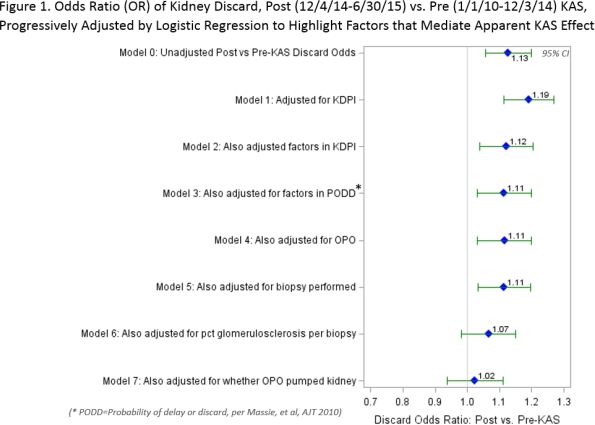Understanding the Initial Rise in Kidney Discard Rates Observed Post-KAS.
1UNOS, Richmond, VA
2Emory Univ, Atlanta, GA
3Univ Hosp Case Med Ctr, Cleveland, OH.
Meeting: 2016 American Transplant Congress
Abstract number: 214
Keywords: Allocation, Donors, Graft acceptance, Kidney transplantation, marginal
Session Information
Session Name: Concurrent Session: Kidney Transplantation: Allocation, Discard, and HCV
Session Type: Concurrent Session
Date: Monday, June 13, 2016
Session Time: 2:30pm-4:00pm
 Presentation Time: 2:42pm-2:54pm
Presentation Time: 2:42pm-2:54pm
Location: Veterans Auditorium
Background: Kidney discard rates increased by 10% — from 18.3% to 20.2% (p=0.001) — during the first 7 months of KAS but returned to pre-KAS levels (17.9%) during the subsequent 4 months. This study aimed to understand the causes of the increase as the OPTN/UNOS continues to closely monitor trends.
Methods: Logistic regression on OPTN data was used to perform effect mediation analysis to determine which factors explain the apparent KAS effect on the discard rate, and to assess whether characteristics of post-KAS match runs were independently predictive of discard. Pre-KAS era: 1/1/10-12/3/14, Early post-KAS: 12/4/14-6/30/15, Later post-KAS: 7/1/15-10/31/15.
Results: The post-KAS increase in the discard rate – odds ratio=1.13 (95% CI: 1.06, 1.20) – was not explained by changes in KDPI, DCD, cause of death, donor comorbidities, nor the rate of performing biopsies among recovered kidneys. However, the combination of (a) poorer biopsy findings (increase from 9.5 to 12.5% having glomerulosclerosis>20%) and (b) a sharp decline (38% to 25%) in pumping of KDPI>85% kidneys by OPOs appears to fully explain the apparent KAS effect (Fig 1). 
A higher # of non-local centers with CPRA 99-100% candidates on the match run was independently associated with lower odds of discard (p<0.001), presumably due to higher acceptance rates for these patients. The # of regional-to-local-center “toggles” when allocating KDPI>85% kidneys to a combined local/regional list was not significant (p=0.38). The return to pre-KAS discard rates in months 8-11 was only partially explained by lower KDPIs and improved biopsy findings among recovered kidneys.
Conclusions: The initial post-KAS rise in discard rates may be entirely explained by poorer biopsy findings and less pumping. The decline in pumping for KDPI>85% kidneys suggests KAS may have affected behavior. However, match run characteristics unique to KAS were not associated with increased odds of discard, and discard rates appear to have returned to pre-KAS levels. Future refinements to allocation may help address the long-standing problem of high discard rates.
CITATION INFORMATION: Stewart D, Kucheryavaya A, Brown R, Klassen D, Turgeon N, Aeder M. Understanding the Initial Rise in Kidney Discard Rates Observed Post-KAS. Am J Transplant. 2016;16 (suppl 3).
To cite this abstract in AMA style:
Stewart D, Kucheryavaya A, Brown R, Klassen D, Turgeon N, Aeder M. Understanding the Initial Rise in Kidney Discard Rates Observed Post-KAS. [abstract]. Am J Transplant. 2016; 16 (suppl 3). https://atcmeetingabstracts.com/abstract/understanding-the-initial-rise-in-kidney-discard-rates-observed-post-kas/. Accessed December 19, 2025.« Back to 2016 American Transplant Congress
